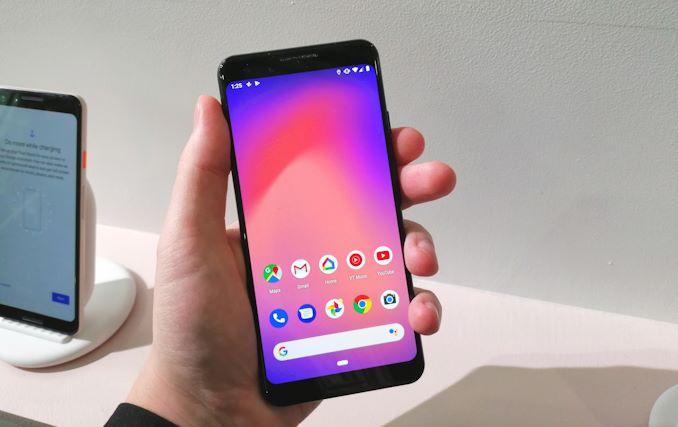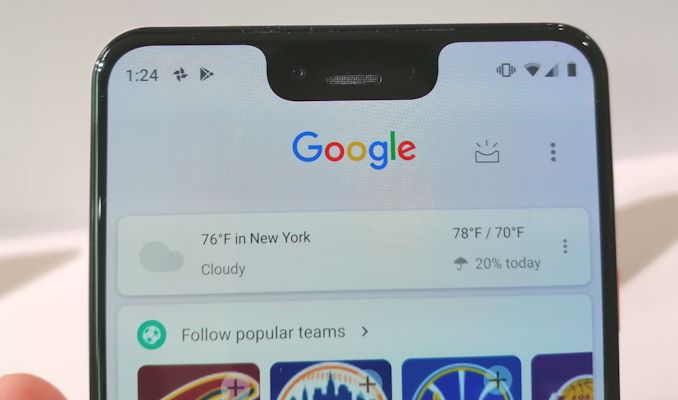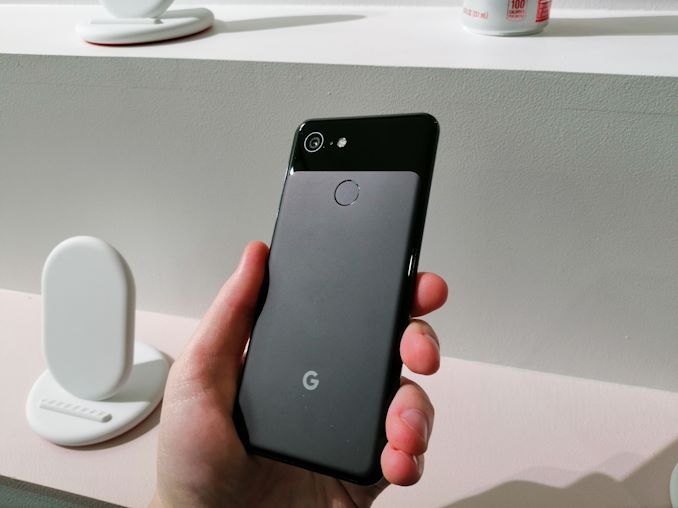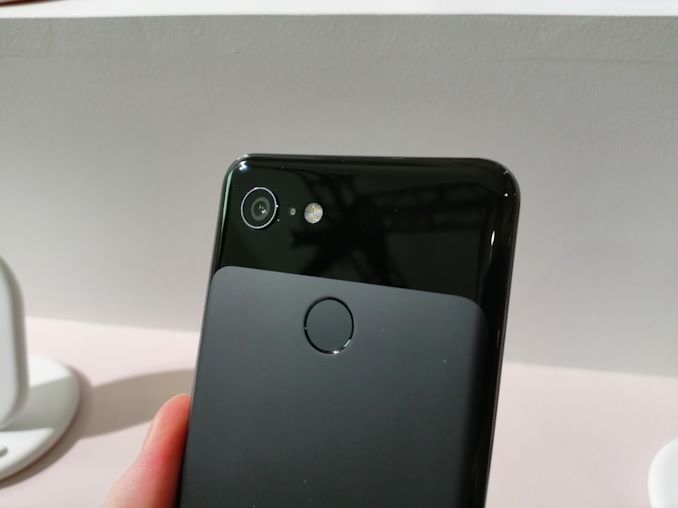Google Launches the Pixel 3 & Pixel 3 XL
by Andrei Frumusanu on October 9, 2018 2:00 PM EST- Posted in
- Smartphones
- Mobile
- Pixel 3
- Pixel 3 XL
It has likely been the most leaked phone in existence, and while there’s a lot we’ve known about the new Pixel 3’s – today Google has finally officially announced the new devices at its launch event in New York. Here’s the summary of the new hardware of software of Google’s new flagship smartphone for the end of 2018.
The Pixel 2 phones have been relatively successful phones for Google and grown to have a notable following. Today’s launched Pixel 3 devices iterate on last year’s phones, improving on aspects that differentiated Google’s phones from other manufacturers, such as the camera.
| Google Pixel 3's | |||
| Pixel 3 | Pixel 3 XL | ||
| SoC | Snapdragon 845 4x Kryo 385 Gold (Cortex A75 based) @ 2.8GHz 4x Kryo 385 Silver (Cortex A55 based) @ 1.76GHz |
||
| GPU | Adreno 630 @ 710MHz | ||
| DRAM | 4GB LPDDR4X | ||
| Display | 5.5" AMOLED 2160 x 1080 (18:9) |
6.3" P-OLED 2960 x 1440 (18.5:9) |
|
| Size | Height | 145.6 mm | 158.0 mm |
| Width | 68.2 mm | 76.6 mm | |
| Depth | 7.9 mm | 7.9 mm | |
| Weight | 148 grams | 184 grams | |
| Battery Capacity | 2915mAh | 3430mAh | |
| Wireless Charging | Qi | ||
| Rear Camera | 12.2 MP, f/1.8, 27mm (wide), 1/2.55", 1.4µm, OIS, dual pixel PDAF |
||
| Front Cameras | Dual 8MP modules Regular f/1.8 75° & wide angle f/2.2 97° FoV lenses |
||
| Storage | 64 GB / 128 GB | 64 GB / 128 GB | |
| I/O | USB-C | ||
| Wireless (local) | 802.11ac Wi-Fi + Bluetooth 5.0 LE + NFC | ||
| Cellular | CAT 16 (1Gbps DL / 75Mbps UL), 5x DL CA, 4x4 MIMO, LAA, 256-QAM DL and 64-QAM UL |
||
| Splash, Water, Dust Resistance | IPX8 (Water resistant up to 1m) |
||
| Dual-SIM | nano-SIM | ||
| Launch Price | 64 GB: $799 / £739 / 849€ 128 GB: $899 / £839 / 949€ |
64 GB: $899 / not avail. / 949€ 256 GB: $999 / £969 / 1049€ |
|
Hardware wise the new Pixel 3 and Pixel 3 XL are powered by this year’s Snapdragon 845 processor. We already saw Qualcomm’s SoC in a mass of handsets from a variety of vendors, and it performed excellently in every one of them. For the Pixel phones, what would likely be a bigger differentiation, is how Google will handle the software side of things. Qualcomm’s Snapdragon 845 scheduler differentiated a lot from the “vanilla” Android kernel – and I think Google will want to continue to use its own scheduling.
The device comes with 4GB of LPDDR4X. I don’t think this is an issue, even if some flagship devices this year sport larger capacities. Onboard storage comes in 64 and 128GB options.
Starting off with the design of the Pixel 3, Google has elongated the screen aspect ratio to 18:9 and reduced the top and bottom bezels compared to the Pixel 2. Over this updates the design with the trend with what we’ve seen in 2018, as phone’s screen-to-body ratio continues to grow.
The Pixel 3 XL is where Google is definitely taking a large design risk: The new XL also increases the screen-to-body ratio over the 2XL, however this comes with the introduction of a massive new screen notch. Now I can’t really be accused of being anti-notch, as I found it to be a complete non-issue on all of this year’s reviewed devices, including Huawei’s P20’s, the OnePlus 6 as well as the LG G7. However Google’s take on the notch is definitely weird: It’s almost twice as high as that of other vendors, which makes one question exactly how this will actually look in daily app usages and if it’s actually of any benefit in terms of notification bar space. Subjectively, it does look ridiculous, but we’ll hold off definitive conclusions until we’ve had time with the phone.
The new Pixels now introduce wireless charging, and this is thanks to the new all-glass backs of the phones. Google achieves the two-tone look by applying a new method that just etches part of the glass, leaving a similar glossy top as on the Pixel 2’s.
This year’s water resistance has been raised to an IPX8 rating, up from the IP67 of the Pixel 2’s. Google seemingly didn’t certify this year’s devices for dust resistance – hence the missing number in the IP rating. As a reminder, this doesn’t mean that the resistance is any worse.
Where the Pixel 2 XL didn’t shine is the screen: LG’s POLED panel on last year’s big phone suffered from large issues, with the biggest one being the screen’s terrible performance in low brightness, where it would just not be able to display darker colours and instead just clip to black. The new Pixel 3 XL at first glance seems to have improved a lot in this regard, and hopefully addresses what was in my opinion the Pixel 2 XL’s biggest issue.
The camera on the new Pixel 3’s sports the same hardware characteristics: a single f/1.8 12.2MP rear module with a 1.4µm sensor as well as OIS. We don’t have much information on the sensor or how the camera hardware improved at the time of writing.
What is clear though is that Google has vastly improved the software of the camera. The three highlight features are “Top shot”, “Super res zoom” and “Night sight”.
Top shot looks to be a continuous shooting mode buffer around the time you are pressing the shutter button. The phone saves pictures even before you pressed the button, and allows you to choose the best shots in a series.
Super resolution zoom is something I’m very excited about: Even though the new Pixel 3’s don’t have a dedicated zoom camera, they still provide a zoom functionality with increased image quality. What Google is doing here is taking multiple shots in a very fast burst (or either using a continuous camera stream), and making use of the slight spatial variations caused by the movement of the camera to get multiple shots. These are then interpolated together with help of the Pixel Visual Core’s processing capabilities to create a higher resolution image. It would be very interesting to see if Google is able to produce higher resolution shots not only when just zoomed in, but also at full frame.
Finally “Night sight” is something that sounds akin to Huawei’s new night mode – where the camera takes several exposures and recombines them in a stacked result that vastly improves the low-light performance of the phone.
As for the Pixel Visual Core – we’re not sure if this is the same silicon as last year, or if Google has iterated and provided with a successor chip.
The front-facing camera system has seen the addition of new wide-angle module, on top of the regular selfie camera. Both are 8MP units, with the regular one coming with an f/1.8 aperture and the wide angle offering an f/2.2 aperture.
The new Pixel 3’s speakers are said to have also been vastly improved, being 40% louder as well as being calibrated for better low and high frequencies.
Overall, today’s Pixel 3 launch event was very much centred around the camera, which Google confidently now calls the “best camera on a smartphone”. Certainly in terms of computational photography, it seems Google made big leaps, and I’m especially eager to see the new super resolution zoom and night sight modes work in practice.
Google offers the Pixel 3 starting at $799 for the 64GB model, and $899 for the 128GB model. The Pixel 3 XL starts similarly at $899 and comes in at $999 for the larger capacity. The Pixel 3’s are available for pre-order now, with full availability in the US starting on the 18th, and European and other countries starting on November 1st.
















86 Comments
View All Comments
mode_13h - Wednesday, October 10, 2018 - link
I don't doubt the technical justification for the price, on the basis of fancy machine learning hardware, etc. I just think they departing from the reality of what these phones are actually worth to people.grant3 - Tuesday, October 9, 2018 - link
As usual, a bunch of bitching about the "notch", even though it can clearly be turned off as seen in one of the article's photos.Of all the problems this phone has, "notch" should not qualify for the top-5.
Skiddywinks - Tuesday, October 9, 2018 - link
If you consider extending the notch laterally to the edges of the screen to be equivalent to the "disabling" of it, then you might be right.Hulk - Tuesday, October 9, 2018 - link
I have a Pixel 2. Great phone.The only thing I'd notice if I switched to the Pixel 3 is the wireless charging.
I'm not even tempted to "upgrade."
flymee2themoon - Wednesday, October 10, 2018 - link
The lack of headphone jack on the pixel 2 annoys me every single day. I am a heavy podcast user, and I listen to music, and I use the headphones for hearing calls clearly. Bluetooth headsets are expensive and require me to keep up to date with how much capacity they have left. They are also easy to lose, and costly to replace. Even the USB C to 3.5mm dongle has proven troublesome. A barrel connector didn't just happen. There are good reasons for long cables to be connected to a device by a circular connector. It's hard wearing for a start. I have broken 3 Pixel 2 devices with stress places on the USB C / 3.5 mm connector, and the current replacement, I am terrified to even use with the dongle now, so I no longer listen to podcasts, or listen to music. On my 128GB device - that I bought for the luxury of carrying my music collection with me.As far as the notch goes, I could never tolerate a notch that large. Some can, happy for you, but it's so large, and so distracting, I just despise it. And that's the issue. I'm not spending a premium amount of money on a device that has so little respect for getting the little things right.... Like being able to listen to music without keeping track of if the headphones are charge, or without running the risk of the stress of the dongle breaking the port, or without being able to see the whole screen.
Samsung so far is the voice of sanity, but who knows for how long. These design professionals that manufacture these "trends" are trapped in a bubble where the unthinkable is the norm, and where rational design is regressive.
I'll stick with my Pixel 2, and I use a Moto E now for podcasts, and listening to music. It's a shame that I can no longer buy a premium device that does everything I want it to do, and a shame that smartphones (and smartphone oss) seem to be designed to hammer the storage so hard as to wear it out in 2-4 years. I can't even buy older devices that had rational designs because they had designed obsolescence built in (unless they are unused).
So, I just wait for the notch trend to end, and I suppose we'll never get the headphone jack back. What an absolutely pathetic state of affairs.
Tams80 - Wednesday, October 10, 2018 - link
"A barrel connector didn't just happen. There are good reasons for long cables to be connected to a device by a circular connector. It's hard wearing for a start. I have broken 3 Pixel 2 devices with stress places on the USB C / 3.5 mm connector, and the current replacement, I am terrified to even use with the dongle now"It's refreshing to see someone else with this opinion. Some people I swear don't have their brains switched on and just go with anything. No. A USB C port is not the ideal port, especially for something that is going to cause it a lot of stress.
varase - Wednesday, October 10, 2018 - link
The lightning connector is the closest you're going to get to a barrel connector.K-lob - Wednesday, October 10, 2018 - link
I still wish my pixel 2 xl had flat edges, 256gb, 3.5", smaller bezel. That is the biggest notch of any phone ever... Hopefully the new screen performs better.beginner99 - Wednesday, October 10, 2018 - link
Too big, too expensive. If i'm ready to pay apple prices I can as well just buy apple as their SOC is obviously way ahead of anything else.Harry_Wild - Wednesday, October 10, 2018 - link
I heard talk from several pro photographers that this new Pixel 3 might be better then what they are using currently - Nikon D850, Canon EOS-1D Mark II!